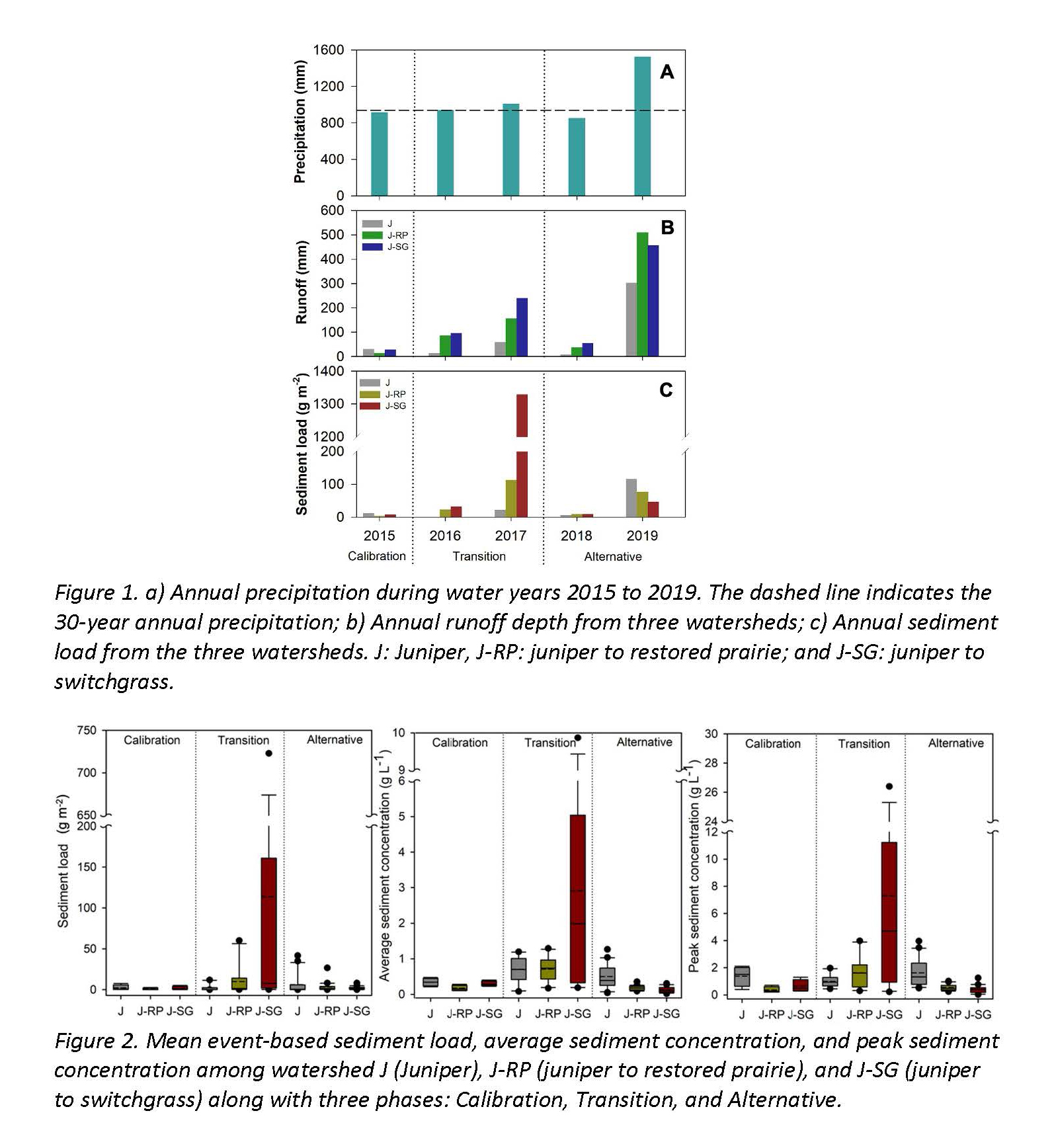
Converting Eastern Redcedar Woodland to Native Prairie or Switchgrass Production Systems Increases Water Yield without Increasing Sediment Yield
EPSCoR Update - May 2022
Land use in the Southern Great Plains (SGP) is primarily for livestock grazing in rangelands dominated by grasses. The surface runoff from these grass-dominated rangelands serves as an important water source for the streams, farm ponds, and reservoirs, which are critical for agriculture, industry, and municipalities. Land-use change can increase soil erosion and sedimentation in surface runoff which can impair streams. The SGP is characterized by rapid land use and vegetation change and experienced substantial soil erosion related to row-crop agriculture and the 1930s Dust Bowl. Land use has a major impact on water quality and quantity of surface runoff into streams. Reduction in herbaceous vegetation cover, which can be due to overgrazing, fire, and woody plant encroachment, can alter surface runoff and increase sediment transport in grasslands.
Eastern redcedar, Juniper virginiana, has encroached into grasslands across the SGP. Mechanical removal of juniper, which is a common management practice in rangeland, is often necessary to re-establish dominance of herbaceous vegetation for heavily encroached watersheds. However, little is known on the impact of juniper removal on water quality and quantity of runoff into streams and reservoirs.
 Hence, Drs. Chris Zou and Rodney Will, professors of Natural Resource Ecology and Management at Oklahoma State University (OSU) collaborated with Drs. Yu Zhong, Tyson Ochsner, and Lan Zhu, and Mr. Adrian Saenz also from OSU, to quantify the impact of mechanical removal of juniper woodland and subsequent re-establishment of tallgrass prairie or switchgrass stand on sediment concentration and loads at the experimental watershed scale in the SPG.
Hence, Drs. Chris Zou and Rodney Will, professors of Natural Resource Ecology and Management at Oklahoma State University (OSU) collaborated with Drs. Yu Zhong, Tyson Ochsner, and Lan Zhu, and Mr. Adrian Saenz also from OSU, to quantify the impact of mechanical removal of juniper woodland and subsequent re-establishment of tallgrass prairie or switchgrass stand on sediment concentration and loads at the experimental watershed scale in the SPG.
“We conducted our study in three juniper-encroached watersheds at the OSU Range Research Station located in Stillwater, OK using a paired experimental watershed approach,” Zou said.
The research team established a juniper Control watershed (J) and the two Impact watersheds, which were initially heavily encroached by juniper.
“All juniper trees in the two Impact watersheds were cut, left to dry on site and then removed seven months after these were cut,” Zhong said.

“One Impact watershed was left to re-establish naturally and was assigned as juniper to restored prairie watershed (J-RP) and the second Impact watershed was planted with ‘Alamo’ switchgrass cultivar that was assigned as juniper to switchgrass watershed (J-SG),” Zhong added.
“We found that converting eastern redcedar woodland to native prairie or a switchgrass biomass production systems increased water yield in streams but had a relatively small impact on sediment yield,” Will said.
“We also found that conversion of a marginal grassland to a low-input switchgrass production system did not significantly change water yield but reduced sediment yield,” Zou said.
“One year after the grasslands were re-established, sedimentation was similar or lower than that of juniper woodland,” Zhong added.
“The runoff from switchgrass production system carried and produced less sediments than that from naturally restored prairie,” Zhong said.
The significance of these findings is that an increase in runoff and decrease of soil erosion can be achieved on the same property by managing the vegetation to reduce woody plant encroachment.
Ongoing studies by the Terrestrial Water and Carbon Dynamics team will help us understand how vegetation structure and functional group, plant species diversity and rooting structure, and soil types affect soil hydrological properties and flow pathways in each watershed.
________________
Acknowledgment:
This work was initiated with support from AFRI Sustainable Bioenergy program 2014–67010-21653, McIntire Stennis OKL0 3151 and OKL03152 from the USDA National Institute of Food and Agriculture and is supported in part by funding through awards from the Oklahoma Center for the Advancement of Science and Technology for project number PS20-015 and the National Science Foundation under Grant No. OIA-1946093 through OK NSF EPSCoR.
________________
